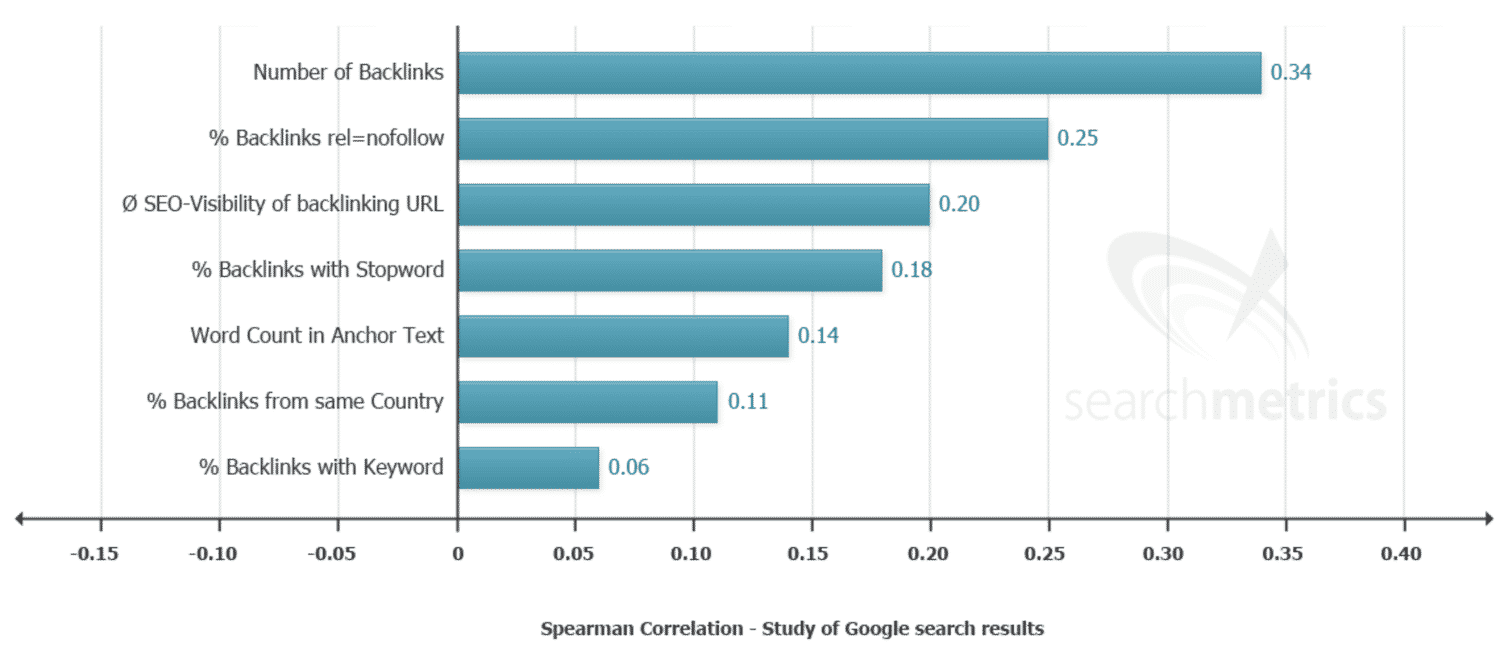Mention link building to most business owners and you’re likely to get weird stares as their minds replay thoughts of a previous bludgeonings by Google Penguin. But that punishment wasn’t the result of link building; it was the result of bad business practices (i.e., buying links). No matter what you think about the process of building links, this much is clear:
Links remain one of the most important elements in your business’s efforts to gain traffic, authority and drive conversions.
Don’t believe me? Take a look at the Link Ranking Factors from SearchMetrics’ SEO Ranking Factors for 2014:
Click image to expand size
While this chart only tells a smart part of the overall story, it does highlight that links still play a significant role in the overall ranking of a website. (Take a look at the complete list here.)
It’s pretty apparent that the role of links, while diminishing by comparison to content and social, isn’t going away any time soon.
“Links aren’t dying…We just need to focus on building better ones.” Link building expert Julie Joyce, owner of LinkFish Media.
I couldn’t agree more.
I also propose that we take a different approach to link building as well. If your company or agency has engaged in “traditional” link building, it likely looks something like this:
- Identify a target you’d like to get a link from
- Have a staffer reach out ask for a link to a piece of content or web page
- Staffer sends emails with the same ask
- More calls
- More emails
Sound familiar?
Or, maybe your business is heavily involved in content marketing already, and you have a pretty good process in place. Instead of the hard sell, your team identifies your audience, determines where they go to consume and share content, creates content along the lines of what they normally share, then reaches out to them.
Certainly a better approach.
The framework above looks something like this:
Audience > Platform > Create Content > Outreach > Links
I have a much, much different—and, I think, more effective way of doing link building—and it’s one I think your business should give a try.
Link building begins with a content-first mindset.
When brands put users first in creating content all too often the messaging of the brand falters, and with it their link building or content marketing efforts.
For example, say you’re a brand that’s done your homework, discerning your target audience is Millennials who mainly use Snapchat and Instagram. You then go about creating highly visual content, which you share on those platforms and then begin outreach efforts in hopes of acquiring links.
In this scenario, which we see played out daily, the content is typically off-message, created only for the purpose of getting links and mentions but having very little to do with the overall goals of the brand.
It’s why we so many poorly targeted, poorly executed infographics. The social team notices the popularity of infographics; the SEO folks salivate at the link opportunity; and the content and design teams realize the information is already at hand and they can deliver a shiny infographic in two days.
You end up with something like this:
Remember, every piece of content you create, and every endeavor you undertake to share such content, must have clear, definable goals and metrics associated with the larger goals of the business.
This serves to take the emphasis off vanity metrics (e.g., shareability) and places it on what the brand, overall, is trying to accomplish.
By taking a content-first approach that’s informed by users, you create wins for everyone.
Here’s how it looks:
- You commit to only producing content that’s impactful, resonant and in line with your core branding (this assumes your brand was established after identifying your ideal prospects)
- You continue to gain clarity on the members of your target audience who’re willing to support your brand (e.g., customer, ambassador, advocate, etc.)
- You identify the platforms they’re using to share and link to content
- You become a visible, active participant on those platforms, with hopes of creating a meaningful relationship
- You notice certain members sharing, linking to and engaging around your content
- You reach out to those members (a) who’ve shared your content, (b) who are the most active, visible and (c) who are the most influential to ask about the types of information that’s lacking in the sector (you might even ask them to be a part of the content, as part of a co-marketing effort)
- You produce the type of content the audience members highlighted as missing
- You ask if they would be so kind as to share the content
- You share it and give audience members credit for their help
Notice anything different with this approach?
Great Content > Audience > Platform > Engagement > Outreach > Links

While a commitment to great content is tough to stick with over time, the effort is well worth the trouble. Why? Most of the competition doesn’t care enough to begin down this path.
It’s too easy to define the audience, find out where they congregate and then start peppering them with content similar to what they already read, share and (sometimes) link to. If your business hopes to earn links, and not just beg for them, you need must commit to creating compelling, novel and indispensable content. Is it hard? Yes. But is it scalable? Absolutely.
Google’s head of webspam, Matt Cutts, seems to convey a similar message in this video from SMX Advanced 2014: “If you do enough excellent, interesting, useful, funny, compelling stuff, usually your reputation, or your links, however you want to think of it, takes care of itself.”
I don’t agree that great information is all it takes to get links. But, in my experience, it is part of the surest path to acquiring links.
What are your thoughts?



